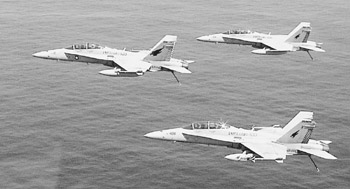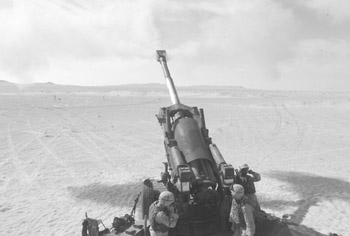511 in Operation Desert Storm
5/11 in Operation Desert Storm
In the days preceding the ground phase of Operation Desert Storm in 1991, then “Lieutenant Colonel James L. Sachtleben, commanding officer of 5th Battalion, 11th Marines, combined artillery , air, direct fire, and electronic warfare to disrupt and demoralize Iraqi defenders located along a fifty-kilometer section of the border between Saudi Arabia and Kuwait.
Sachtleben s seniors chose his artillery battalion to conduct a series of raids prior to the beginning of the ground phase because they needed a force that could emplace and withdraw quickly, deliver a decisive blow to Iraqi positions , and reach the enemy from the Saudi Arabian side of the border. Artillery, long known as the King of Battle, could deliver 155mm and 203mm projectiles that weighed 100 pounds and 200 pounds , respectively, and that ranged 11 and 18 miles, respectively.
But Sachtleben realized during his unit s preparations that it was apparent that these raids would truly be a combined arms effort. [10] Accordingly, he assembled a fighting force that was custom-tailored for the demanding requirements of his mission. In addition to his artillery units, F/A-18 Hornet fighter-bomber jets were on-station, ready to drop Rockeye cluster bombs on targets of opportunity. Eight-wheeled light armored vehicles (LAVs), which fired high-explosive or armor -piercing rounds from a twenty-five-millimeter cannon and traveled at speeds up to sixty miles per hour , provided forward and lateral security on the ground. Electronic warfare assets, including EA-6B Prowler aircraft, were employed to detect enemy radio traffic and jam enemy ground surveillance radar, which was capable of pinpointing the location of Marine artillery fire.
The assembled force possessed a formidable set of capabilities, but equally impressive was the high degree of coordination that existed among its component parts . Sachtleben and his staff enjoyed a close working relationship with the LAV commander, who had played an integral role in mission planning and execution since Operation Desert Shield, the precursor to Operation Desert Storm. And a forward air controller (FAC), an actual Marine pilot who rode with the LAVs, directed the F/A-18 and EA-6B aircraft from his position on the ground as they made their final approaches.
In all, Sachtleben s force conducted four raids ”all under the cover of darkness . During the first raid the LAVs provided security as the artillery moved toward the border, fired several volleys on an Iraqi police post, and hastily withdrew upon receiving mortar fire. To cover the artillery s withdrawal, the FAC called in F/A-18s to bomb the enemy positions.
During the second raid the artillery returned the favor and covered the LAVs with an umbrella of reinforcing fires as the speedy eight-wheeled vehicles conducted a drive-by, direct-fire attack on a second Iraqi police post.
During the third raid the artillery fired on Iraqi ground surveillance radar sites while EA-6Bs jammed the very same sites from the air to prevent Iraqi radar from locating the Marine artillery s firing location and directing accurate counterfire.
During the fourth and final raid artillery continued to rely on the LAVs for security, opted to forgo jamming support from the EA-6Bs, and fired more rounds on two Iraqi artillery units for an extended period of time. The intent was to goad the Iraqi artillery to return fire, and when flashes revealed the Iraqis positions, F/A-18s swooped in and dropped Rockeye bombs with devastating accuracy.
As Sachtleben correctly observed , the cumulative effect of unexpected artillery and direct-fire strikes and near-instantaneous punishment from F/A-18s disrupted and demoralized Iraqi defenders: put yourself in the place of the Iraqi rocketeers: they fired a counter-battery volley in response to our artillery fires, and within seconds of their first and only volley, they were hit by very effective aviation ordnance. Their morale undoubtedly suffered. [11]
Leadership Lessons
Sachtleben realized early on that combined arms would enable him to project maximum combat power, and his tactics grew increasingly innovative with each raid. The first three raids illustrate the complementary nature of combined arms; the fourth illustrates the horns of a dilemma. First, direct fire from the LAVs covered the artillery s attack, and air protected the artillery at its most vulnerable point ”withdrawal. Second, the artillery covered direct fire s attack. Third, electronic warfare prevented artillery s attack from being detected . And fourth, artillery presented the Iraqis with two undesirable alternatives: displace from their positions, thereby weakening the overall Iraqi defense, or return fire, thereby revealing their locations to F/A-18s circling overhead.



Figure 10.2: A modern-day Marine Corps combined arms team ”F/A-19 hornet jets, Light Armored Vehicle with AH-1 Cobra overhead, and an M198 howitzer (heavy artillery). Photos courtesy of United States Marine Corps, www.usmc.mil, July 15, 2003.
Sachtleben also realized early on that a close relationship among the units brought together would greatly enhance the effectiveness of his combined arms approach, and he made a concerted effort to include the leaders of those units in both planning and execution to the fullest extent possible.
[10] Sachtleben, James L., Artillery Raids in Southwestern Kuwait, Field Artillery Journal , October 1991, 26.
[11] Ibid, 29.
EAN: 2147483647
Pages: 145